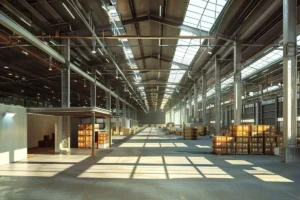
Understanding the Mezzanine Floor: A Smart Storage Solution
For growing businesses facing space constraints, relocating or expanding the building isn’t always practical. A mezzanine floor offers a cost-effective way to increase usable space within an existing facility. In this article, we break down what mezzanine floors are, where they’re used, and how they benefit industrial and commercial operations.
01.
What is a Mezzanine Floor?
Mezzanines deliver a range of operational and financial advantages.
Key benefits include:
- Maximises space: Turns unused vertical areas into productive zones.
- Cost savings: Avoids the expense of moving or constructing new facilities.
- Flexibility: Easily reconfigured or relocated as needs change.
- Increased efficiency: Keeps related operations close together for smoother workflows.
Example: A distribution centre increased its picking speed by 30% after adding a mezzanine for order processing.
02.
Common Applications in Industry
Mezzanine floors are used in a variety of industries to optimise space and streamline operations.
Key benefits include:
- Storage expansion: Create additional shelving or pallet racking areas.
- Office space: Add administrative areas above warehouse floors.
- Production areas: Support light manufacturing processes.
- Retail display: Expand customer browsing areas without expanding floor plans.
Pro Tip: If your warehouse has high ceilings, a mezzanine is the quickest way to utilise vertical space effectively.
03.
Benefits of Installing a Mezzanine Floor
Mezzanines deliver a range of operational and financial advantages.
Key benefits include:
- Maximises space: Turns unused vertical areas into productive zones.
- Cost savings: Avoids the expense of moving or constructing new facilities.
- Flexibility: Easily reconfigured or relocated as needs change.
- Increased efficiency: Keeps related operations close together for smoother workflows.
Example: A distribution centre increased its picking speed by 30% after adding a mezzanine for order processing.
04.
Design Considerations
Before installation, it’s essential to plan a mezzanine floor carefully for safety and efficiency.
Key benefits include:
- Load capacity: Ensure the design supports intended equipment and materials.
- Access points: Incorporate stairs, lifts, or conveyors for easy movement.
- Building regulations: Comply with local safety and fire codes.
- Lighting and ventilation: Maintain safe, comfortable working conditions.
Pro Tip: Engage a professional engineer to evaluate structural integrity before construction.
05.
Maintenance and Safety Tips
Like any structural addition, mezzanine floors require regular upkeep to ensure safety and performance.
- Routine inspections: Check for wear, corrosion, or loose connections.
- Weight limits: Avoid exceeding the designed load capacity.
- Safety barriers: Install railings or netting to prevent falls.
- Clear signage: Mark load limits and restricted areas clearly.
Example: Many warehouses schedule quarterly inspections to keep mezzanines compliant with safety standards.
A mezzanine floor is one of the most practical investments for businesses needing more space without breaking the bank. With the right design and safety measures, it can transform your facility’s efficiency, capacity, and workflow — all while avoiding the high costs of relocation or expansion.



